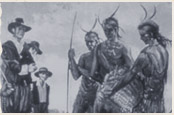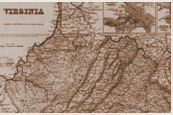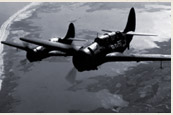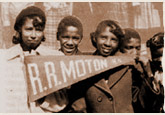Voter Registration in McComb, Mississippi, 1962
University of Southern Mississippi: "Ordinary People Living Extraordinary Lives - The Civil Rights Movement in Mississippi"
Description: This resource is a photograph of a voting rights demonstration in McComb, Mississippi in 1962, accompanied by audio clips from people involved in the struggle for voting rights in Mississippi. McComb (and the state of Mississippi as a whole) was the site of the some of the most violent episodes of the Civil Rights movement. The photograph and audio files offer an opportunity to consider the Southern "grass-roots" origins of the Civil Rights movement, and can spark student discussion of the motivations of ordinary people who were moved to act with extraordinary heroism.
Teaching Tips:
"Do Now" Suggestion
- Students could brainstorm a list of rights they would be willing to fight or protest for, then choose one of those rights to elaborate upon in their journals. Students could share their responses before beginning their exploration of this site. Students could read one of the excerpts from interviews found on the site, such as the following from voting rights activist Pinkey Hall: "Well, in 1964 I kept trying to register, and Theron Lynd was the deputy registrar at that time. His name was Theron Lynd. And he wouldn't let us register no matter what. You'd go up there. They would put some stiff questions to you. And even if you answered them, he still wouldn't let you pass. He'd send you back and make you come back. You'd just go, go, go and couldn't become a registered voter." Students could respond in their journals to this or one of the other interviews from the site. Responses could include describing what they would do if faced with similar oppression, when they think the interview took place (if the date is removed from her speech) and why, etc. Students could share their responses before continuing their exploration of the site.
- Students could research one of the organizations described in the site: SNCC, CORE, COFO, or the NAACP, as to their role and contributions to the drive for voting rights in Mississippi in the 1950s and 1960s. Students could use this website, plus their textbooks, other books, and other websites, for resources. Students could share their findings with the class in the form of oral presentations or posters or charts. The above site comes from the larger site, "Ordinary People Living Extraordinary Lives: The Civil Rights Movement in Mississippi.," located at http://www-dept.usm.edu/~mcrohb/html/cd/intro.htm. Students could choose an event or year depicted on the homepage timeline, and find several sources of information describing this event. Students could research these different sources to answer the question, "How did this event contribute to African Americans in Mississippi and the rest of the U.S. gaining the power to exercise their right to vote?" Students could have choices of formats for compiling their research, but they should share their responses with the class.



